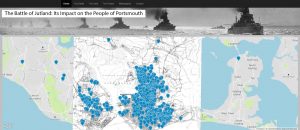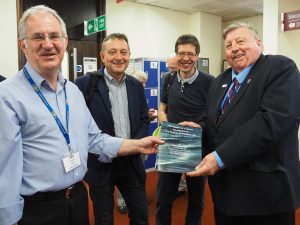 PTUC’s Rob James and John Bolt, Research Assistant and PhD student, have created an online map, with the help of a local community group, Portsdown U3A, which identifies the impact of the Battle of Jutland on the people of Portsmouth and the local area. Below, they relate their experiences of the project and chart its achievements.
PTUC’s Rob James and John Bolt, Research Assistant and PhD student, have created an online map, with the help of a local community group, Portsdown U3A, which identifies the impact of the Battle of Jutland on the people of Portsmouth and the local area. Below, they relate their experiences of the project and chart its achievements.
Follow this link to view the online map and read about the research http://porttowns.port.ac.uk/jutland-map/index.html
The Battle of Jutland took place on 31 May 1916. It was the largest sea-battle of the First World War, and was one in which many men from both the British and German navies perished. To mark its 100-year anniversary, a group of researchers from Portsdown U3A decided to conduct a research project to honour the local people who had died in the battle. Their aim was to identify the names of the 662 men from Portsmouth and the local area who had perished and create a Roll of Honour. Portsdown U3A’s Jutland research group planned to display the Roll of Honour at a series of pop-up exhibitions across the city of Portsmouth. The exhibition would also include a number of detailed information panels summarising the battle, as well as featuring short biographies of some of the men from the area who had lost their lives.
In May 2015 two members of the group, Carole Chapman and Steve Doe, arranged a meeting with Rob to discuss how they could take the project further. They had planned on submitting a Heritage Lottery Fund (HLF) grant application in order to finance their exhibition, but were seeking ideas for what else they could do to develop the project. Rob had been working on a mapping project with the Port Towns and Urban Cultures team in which the heritage of Portsmouth’s ‘Sailortown’ districts was being plotted on to contemporary maps as a resource for academics and visitors to the city (see the ‘Sailortown’ app), and suggested that the U3A could create a map that would detail the loss of men from Portsmouth and the local area. It was decided that a paper copy of the map would be created to take around the various pop-up exhibitions, as well as an online map that would be hosted on the PTUC website, where visitors to the site would be able to click on the various ‘pins’ in order to find out more about the men who had lost their lives. The plans had been made; now all that was needed was success in the planned HLF application…

Portsdown U3A’s Steve Doe presents their publication of findings to Portsmouth City Councillor Frank Jonas. With Professor Brad Beaven and Dr Rob James.
It was with delight and great relief that the U3A heard that their grant application to the HLF was successful. Their vision could now become reality. The grant allowed co-investigator Rob to employ John as a research assistant in order to create the required maps. After taking receipt of the huge database the U3A had collated, John began work on verifying all of the information he had to hand, checking it alongside a database that PTUC’s Dr Mel Bassett had been working on as part of an AHRC-funded project that captured the national casualties of the battle (to access the database go to http://porttowns.port.ac.uk/source-information/jutland-casualty-database/). Once the data had been verified John, along with the team of Online Course Developers (OCDs) at the University, began working on the paper map. This process consisted of plotting each participant of the battle who had a link to Portsmouth on to a 1910 map of the Portsmouth area by using information on next of kin and their places of birth.
After the paper map was completed, John and the OCDs started work on the online map. An historic map of Portsmouth was overlaid on to a current Google map of the city so that all of the service personnel’s locations could be plotted on the map. This did create a number of difficulties, not least because many street names had changed or vanished due to the passing of time, from both war and urban renewal, which a computer programme is not able to immediately recognise. After many hours working through the database, John was able to accurately locate the vast majority of men using multiple resources, including contemporary Ordnance Survey maps and local history sites (a few couldn’t be located exactly due to incomplete records). The map was now ready to launch!
It is with great excitement, then, that this blog announces the launch of the online map that reveals the details of the sailors who lost their lives during this momentous First World War battle between two of the world’s biggest navies of that time. I hope you find it a fascinating tool for understanding the extent to which the Battle of Jutland impacted Portsmouth and the local area. The map also demonstrates that there are further opportunities for plotting the effect of other events and battles on contemporary maps. Ideas for future projects are therefore welcome!










Comments are closed.